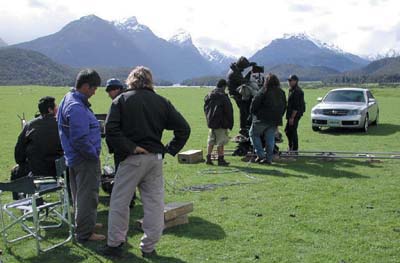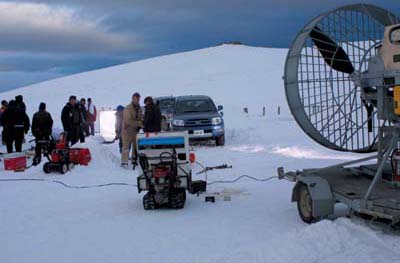Home is Where the Car Ads Are
Back to Contents of Issue: February 2003
|
|
|
|
by Debbi Gardiner |
|
 THE OAK-LINED ROAD to Fairlie once meant only one thing to me: the best way to get to Lake Tekapo so that my granddad Dudley and I could fish for trout. Now when I'm home, especially when the autumn leaves turn golden and the mountains get covered with snow, line-production crews for Lexus, BMW, Cherokee and Nissan often dot the meandering roads. Carmakers have long recognized the bonuses of filming their television commercials in New Zealand. The seasons, directly opposite the seasons of the Northern Hemisphere, let clients shoot winter ads in their summer and vice versa. With the 2:1 exchange with the US (two New Zealand dollars buy one US), production teams come cheap. And best of all, the nature is stunning, says Jacqui Wood, promotions manager for Film South, a regional film commission in the South Island. While New Zealand typically has to compete with neighboring Australia, the US and South Africa to woo the attention of car manufacturers, this year line-production teams report being swamped. "We are very, very busy," says Wood. "Advertising houses for big carmakers are choosing us over competitors. We have several billion dollars worth of feature films tentatively booked here over the next two years as well. We are in vogue," she says. Take a look at TV car ads in Japan this winter, and chances are New Zealand's rolling hills and raw landscapes appear as the backdrop. Last September, Lexus wrapped up a 52-day still shoot in South Canterbury and Otago for the new GX 470 model. The Toyota Mark II's pilot commercial was filmed near Mount Cook, the Nissan Gloria's in a provincial university town called Dunedin. Queenstown was the setting for the new Toyota Ilux Surf commercial, says Tatsu Kuwasaki, whose Queenstown-based line-production company, Nature Spirit, works with big agencies such as Dentsu. European car manufacturers are tickled with New Zealand as a locale too. Commercials for Renaut, BMW and Citroen were all filmed there, notes a government group, Trade New Zealand, in its 2001 report. While nobody seems to be keeping track of exact figures, line producers such as Kuwasaki report a 30 percent increase in business from Japanese car companies in the past year. The recent surge of interest in New Zealand, industry officials say, is in part due to the Lord of the Rings. The epic Peter Jackson film, which was filmed and produced in New Zealand, put the island nation on the radar of advertising agencies all over the world. And one of the many plugs Kuwasaki makes to Japanese ad agencies is the country's diverse landscapes. "In New Zealand, within a few hundred miles, film crews can travel to mountains, lakes, rolling hills, rivers and dense bush. This saves cost and time," he says. The Film South Web site (www.filmsouth.com) posts snapshots of scenery that could pass as deserted country roads in the American Midwest, churches in England, Swiss villages, even parts of Japan. The Peter Jackson film also showed overseas agencies that New Zealand film crews and technicians could handle more lucrative and tricky post-production work, too. In the last year, New Zealand's government has invested hefty sums into promoting this. In September 2001, then energy minister Pete Hodgson, for instance, was named "Minister of the Rings." The government then spent over $1.8 million for Lord of the Rings related promotions for tourism, technology and filmmaking. The trailer for the new installment, The Two Towers, is little more than a plug for visiting the islands, some indignant fans complain. Another reason more Japanese crews come down to New Zealand is safety. Since September 11, companies which once filmed in the US feel cagey and are looking for alternate locations. New Zealand is still known to the Japanese as a "safe" filming destination, says Maurice Kerr, a Queenstown-based line producer who was busy producing the commercials for Mitsubishi Airtrek and Toyota Premio in 2001. "The perceived threat of terrorist actions overseas is probably one of the biggest concerns to a producer wishing to go shoot outside Japan," Kerr says.  Film experts in Japan also point to the more pressing problem: location. In Japan there is just not enough space for films, especially period films, let alone car commercials. "The locations just aren't there any more," says Mark Schilling, the Japan correspondent for Screen International, a British trade magazine, and the author of Contemporary Japanese Film, a book published by Weatherhill. New Zealand is the same size as Japan but has a population of just under 4 million people. Visitors can trek for hours and not encounter civilization. The Main South Road highway through Canterbury, a popular spot for car commercials, is just a single lane. Sheep graze in paddocks on either side. This year Schilling helped with the Japanese dialogue for The Last Samurai, a new Warner Brothers blockbuster featuring Tom Cruise. The film, set in 18th century Japan, began filming in Taranaki, a sleepy town in New Zealand's North Island, this January. Mount Taranaki, roughly the same size as Japan's most famous mountain, poses as Mount Fuji in the film. When Schilling asked director Ed Zwick why he wasn't shooting in Kyushu where most of the film's action takes place, the director said he would have loved to "but there's too much concrete. Too many power lines." Also, Schilling adds, economically it can make more sense to shoot in New Zealand. Schilling says feature film production has been growing over the last decade from 240 in 1991 to 281 in 2001. Even so, for the average Japanese film, production company budgets are decreasing. Kuwasaki says in his industry production companies have been in serious survival mode for the past four to five years. But New Zealand is a great option when Japanese companies are exploring the most cost effective way to film in a place that retains international standards and quality. @ |
|
Note: The function "email this page" is currently not supported for this page.





